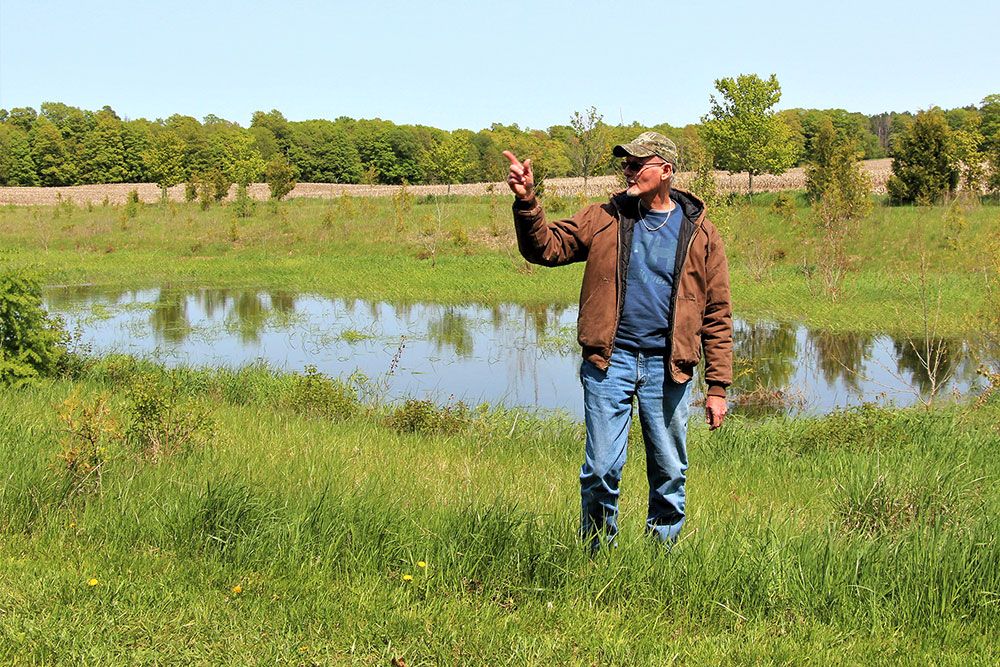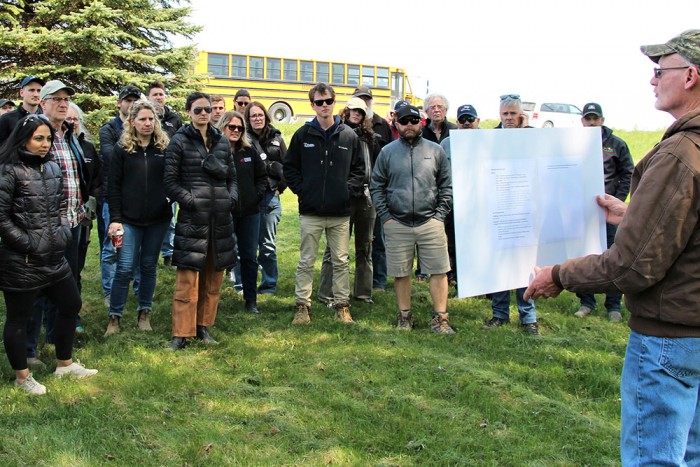Tour of innovative municipal drain projects

Drainage engineers, drainage superintendents tour sites in Huron, Lambton counties to learn innovative practices for municipal drains
Participants learn how nature-based solutions in municipal drains can provide drainage and water management
Close to 50 drainage engineers and municipal drainage superintendents, from southwestern Ontario, toured municipal drains in Huron and Lambton counties on Wednesday, May 17, 2023 to learn about rural green infrastructure and best practices for municipal drains. Attendees visited a number of sites with examples of innovative practices.
Lambton Shores Drainage Superintendent Ryan Griffin provided a tour of a pump drain system and pump house in the Thedford-Klondyke Marsh Area. This low-lying area has no natural outlet for the drained lands so water must be pumped up into the Ausable River and Parkhill Creek. This highly valuable farmland requires effective drainage and it must also meet the demands of water irrigation for crops. This balance is achieved by working with property owners to ensure their needs can be met.
At the Steenstra Drain, Geoff King, Drainage Superintendent for the municipalities of Bluewater and Central Huron, led discussions on innovative drainage design. Participants learned how integrating nature-based solutions, such as wetlands, and off-line sediment traps, can improve the movement of sediment and water within a watershed.
The next stop was the Scott Drain north of Blyth where Maitland Conservation and local landowners have spearheaded several innovative approaches that demonstrate the potential of municipal drainage design. Under the Drainage Act, the definition of a drain is “… a drain constructed by any means.” King, with help from Professional Engineer Jeff Dickson, of R.J. Burnside & Associates Limited (Burnside), fully utilized that definition and incorporated a number of green infrastructure projects at the site that met the needs of the drainage community and the health of the watershed.
Christopher Pfohl, Senior Aquatic Ecologist, from Burnside, demonstrated natural channel design at the Scott Drain. The project design considers the movement of water and sediment utilizing natural channel concepts and providing fish habitat opportunities in the drain design. Watershed Biologist Sarah Snetsinger, of St. Clair Region Conservation Authority, spoke on tile outlet design and the impact it can have on erosion and maintenance needs. Davin Heinbuck, Water Resources Coordinator with Ausable Bayfield Conservation Authority, spoke on sinkholes, buffers, and two-stage ditches.
Partners from the Healthy Lake Huron initiative hosted the municipal drainage tour.
To learn more about Healthy Lake Huron visit the website at healthylakehuron.ca
Funding for the tour of the municipal drainage innovation project is gratefully acknowledged from the Ontario Ministry of Agriculture, Food and Rural Affairs of the Province of Ontario.
PHOTOS:
Davin Heinbuck, Water Resources Coordinator with Ausable Bayfield Conservation Authority, spoke on sinkholes, buffers, and two-stage ditches during a bus tour of almost 50 drainage engineers and drainage superintendents:

Geoff King, Drainage Superintendent for the municipalities of Bluewater and Central Huron, led discussions on innovative drainage design at the Steenstra Drain. Almost 50 drainage engineers and drainage superintendents learned how integrating nature-based solutions, such as wetlands, and off-line sediment traps, can improve the movement of sediment and water within a watershed:

During the May 17, 2023 bus tour, drainage engineers and municipal drainage superintendents visited innovative municipal drain sites learning about nature-based solutions including wetlands and buffers and two-stage ditches:

